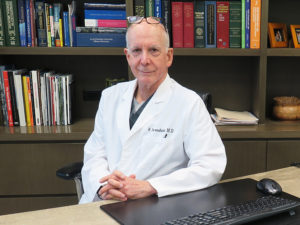Dr. Bernstein and Dr. Shaver attended the 26th World Congress of the International Society of Hair Restoration Surgeons (ISHRS). At the congress, Dr. Bernstein introduced the newest robotic technology in the field of hair transplantation, the ARTAS iX, to an audience of over 550 hair restoration physicians.
Dr. Bernstein was recently a guest on “The Beauty Doc” podcast with a master of oculoplastic & facial plastic surgery, Dr. Joel E. Kopelman. Here, they discussed causes of hair loss in both men and women, the difference between hair falling out and balding, both the mental and physical effects of hair loss, when to come in for a consult and medical and surgical treatments for hair loss.
In this video Dr. Bernstein demonstrates the simultaneous robotic excision and manual extraction of individual hair follicles using the ARTAS 9x Robotic Hair Transplant System. The video highlights new features of the ARTAS Robot that make hair transplant procedures faster and more efficient.
Capsule is a digital pharmacy that connects to your doctors and insurance companies directly and delivers your medicine straight to your door – anywhere in New York City. Capsule works to build the first “holistic” pharmacy that simplifies the process for all parties involved – patients, doctors and insurers. The service allows the doctor to call in a prescription to a Capsule trained pharmacist, who will fill the prescription that gets delivered to you.
Dr. Bernstein’s revolutionary work in developing hair transplant techniques that have tremendously increased the standard of care within the field of hair restoration aligns with Capsule’s focus on patient care and innovation. Dr. Bernstein was interviewed by a journalist from Capsule about his ongoing role in the advancements of hair transplant surgery.
Q: In what cases do you think Scalp Micro-Pigmentation (SMP) is most useful?
When do you think Scalp Micro-Pigmentation (SMP) — M.O., Greenwich, CT
A: Scalp Micro-Pigmentation (SMP) is used in patients who want to make their thinning hair look fuller and want to avoid the nuisance of daily application of cosmetic concealers, powders or fibers. It is for patients who want a permanent solution, but who do not want, or who are not candidates for hair transplant surgery. It can achieve a variety of looks such as a buzz cut by tattooing hundreds of microdots that appear like follicles or it can reduce the contrast between generalized dark hair that is thinning over a pale scalp. It can even give the appearance of hair over a scar that has now become noticeable.
Dr. Shaver performs all Scalp Micro-Pigmentation procedures at Bernstein Medical.
Q: How is Scalp Micro-Pigmentation (SMP) Performed?
How is SMP done? — B.P., Long Island, NY
A: Scalp Micro-Pigmentation (SMP) is applied with tiny microneedles that mimics the appearance of hair in an area of the scalp that looks thin. It requires the use of local anesthesia and is performed in a doctor’s office. SMP is typically performed over a series of three or more sessions spaced at least 2-4 weeks apart. The length of each session varies depending on the area to be tattooed and can last from a few hours to a full day.
To perform successful SMP, the hair length and color must be analyzed in consultation along with a discussion of cosmetic goals and the potential techniques that could be implemented for the patient’s hair type. The procedure is performed under local anesthesia and is generally well tolerated with very few post-op limitations.
Q: What is Scalp Micro-Pigmentation (SMP)?
What is Scalp Micro-Pigmentation? — M.O., Greenwich, CT
A: Scalp Micro-Pigmentation (SMP) is a medical-grade scalp tattoo. It is a form of permanent cosmetic camouflage that can mimic the appearance of hair in locations such as scars or balding areas. SMP gives the appearance of fullness of hair without actual hairs being present. Although permanent dyes are generally used, semi-permanent materials can be substituted that will purposely fade over time.
Dr. Shaver is our dedicated in-house physician for Scalp Micro-Pigmentation procedures.
On March 6th, 2018 the International Society of Hair Restoration Surgery announced an update to the terminology of the FUE hair transplant technique. FUE historically stood for Follicular Unit Extraction but has now been changed to Follicular Unit Excision. The change in terminology is intended to emphasize the surgical nature of the procedure.
May 11th, 2018 – Robert M. Bernstein MD, a pioneer in modern hair transplantation, led five robotic hair restoration physicians in an intensive master class focusing on ARTAS robotic techniques, surgical planning and aesthetics. The day included a live ARTAS Robotic FUE procedure, a series of twelve presentations and a Q & A period. The ARTAS Hair Transplant System, developed by Restoration Robotics, is the only robotic system in the world designed to aid surgeons in hair restoration procedures.
An article in the New York Times discusses research surrounding a potential new hair loss treatment. The NY Times’ article “Old Transplant Drug May Have A Fringe Benefit” states that an immunosuppressant used to prevent organ rejection in those having liver, kidney or heart transplants also stimulated hair growth.









